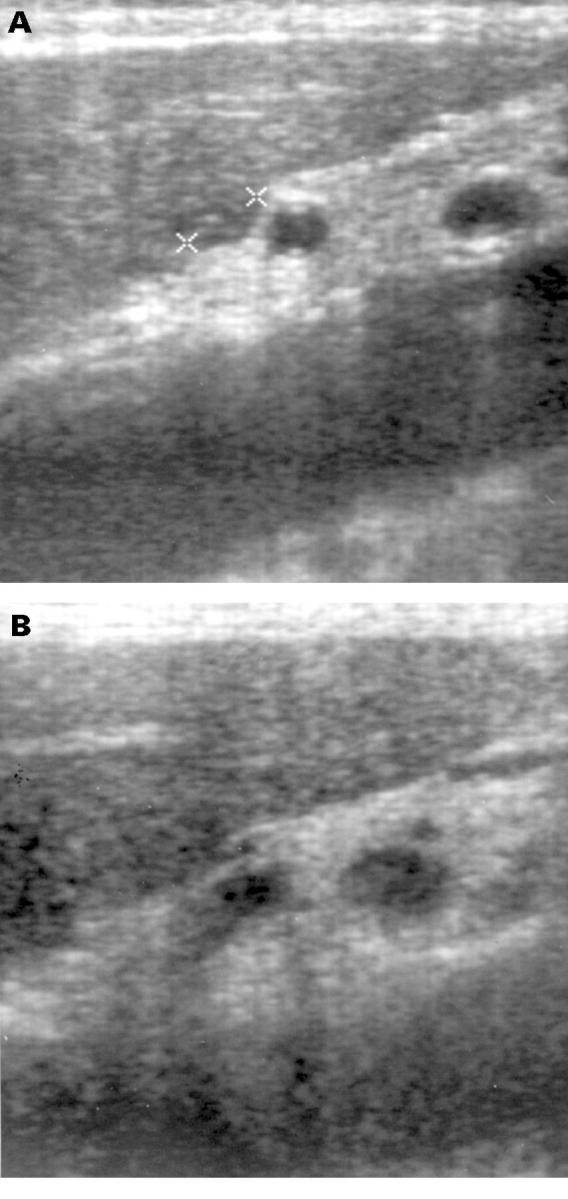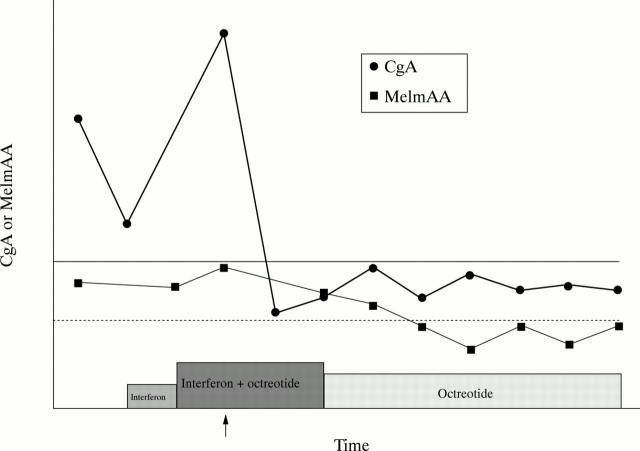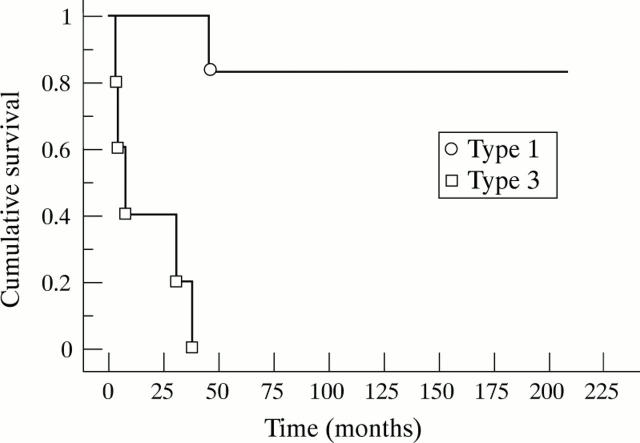Abstract
Background—Type 1 gastric carcinoids are associated with hypergastrinaemia and chronic atrophic gastritis, type 2 occur in patients with multiple endocrine neoplasia type 1 combined with Zollinger-Ellison syndrome, and type 3 lack any relation to hypergastrinaemia. Type 1 tumours are usually benign whereas type 3 are highly malignant. Aims—To identify possible tumour markers in patients with gastric carcinoids. Patients/method—Nine patients with type 1, one with type 2, and five with type 3 were evaluated with regard to symptoms, hormone profile, and prognosis. Results—Plasma chromogranin A was increased in all patients but was higher (p<0.01) in those with type 3 than those with type 1 carcinoids. All patients with type 3 carcinoids died from metastatic disease, but none of the type 1 patients died as a result of their tumours. One type 1 patient with a solitary liver metastasis received interferon α and octreotide treatment. Nine months later, the metastasis was no longer detectable. She is still alive eight years after diagnosis, without recurrent disease. This represents the only reported case of foregut carcinoid with an unresectable liver metastasis that seems to be have been cured by biotherapy. Conclusions—Plasma chromogranin A appears to be a valuable tumour marker for all types of gastric carcinoid. Combination therapy with interferon α and octreotide may be beneficial in patients with metastasising type 1 gastric carcinoids.
Keywords: gastric carcinoids; chromogranin; histamine; interferon; octreotide
Full Text
The Full Text of this article is available as a PDF (158.7 KB).
Figure 1 .

Ultrasonograph of the liver of a patient with type 1 carcinoids (A) before treatment started showing a metastasis of about 1 cm (between the crosses) and (B) after nine months of interferon α therapy, when the metastasis is no longer visible.
Figure 2 .
Chromogranin A (CgA) and MeImAA in the patient with type 1 tumour with a liver metastasis that disappeared during medical treatment. The solid line shows the upper normal range for chromogranin A and the dotted line the upper normal range for MeImAA. The arrow indicates the time at which the liver metastasis was no longer visible on ultrasound examination of the liver.
Figure 3 .
Cumulative survival (Kaplan-Meier plot) in patients with type 1 and type 3 gastric carcinoids.
Selected References
These references are in PubMed. This may not be the complete list of references from this article.
- Almqvist S., Telenius-Berg M., Wästhed B. Serum calcitonin in medullary thyroid carcinoma. Radioimmunoassay technique and diagnostic value. Acta Med Scand. 1974 Sep;196(3):177–180. doi: 10.1111/j.0954-6820.1974.tb00992.x. [DOI] [PubMed] [Google Scholar]
- Borch K., Renvall H., Liedberg G. Gastric endocrine cell hyperplasia and carcinoid tumors in pernicious anemia. Gastroenterology. 1985 Mar;88(3):638–648. doi: 10.1016/0016-5085(85)90131-3. [DOI] [PubMed] [Google Scholar]
- Bordi C., Pilato F. P., Bertelé A., D'Adda T., Missale G. Expression of glycoprotein hormone alpha-subunit by endocrine cells of the oxyntic mucosa is associated with hypergastrinemia. Hum Pathol. 1988 May;19(5):580–585. doi: 10.1016/s0046-8177(88)80208-9. [DOI] [PubMed] [Google Scholar]
- Bordi C., Yu J. Y., Baggi M. T., Davoli C., Pilato F. P., Baruzzi G., Gardini G., Zamboni G., Franzin G., Papotti M. Gastric carcinoids and their precursor lesions. A histologic and immunohistochemical study of 23 cases. Cancer. 1991 Feb 1;67(3):663–672. doi: 10.1002/1097-0142(19910201)67:3<663::aid-cncr2820670323>3.0.co;2-l. [DOI] [PubMed] [Google Scholar]
- Carney J. A., Go V. L., Fairbanks V. F., Moore S. B., Alport E. C., Nora F. E. The syndrome of gastric argyrophil carcinoid tumors and nonantral gastric atrophy. Ann Intern Med. 1983 Dec;99(6):761–766. doi: 10.7326/0003-4819-99-6-761. [DOI] [PubMed] [Google Scholar]
- Creutzfeldt W. The achlorhydria-carcinoid sequence: role of gastrin. Digestion. 1988;39(2):61–79. doi: 10.1159/000199609. [DOI] [PubMed] [Google Scholar]
- Eriksson B., Oberg K., Skogseid B. Neuroendocrine pancreatic tumors. Clinical findings in a prospective study of 84 patients. Acta Oncol. 1989;28(3):373–377. doi: 10.3109/02841868909111209. [DOI] [PubMed] [Google Scholar]
- Eriksson B., Skogseid B., Lundqvist G., Wide L., Wilander E., Oberg K. Medical treatment and long-term survival in a prospective study of 84 patients with endocrine pancreatic tumors. Cancer. 1990 May 1;65(9):1883–1890. doi: 10.1002/1097-0142(19900501)65:9<1883::aid-cncr2820650902>3.0.co;2-3. [DOI] [PubMed] [Google Scholar]
- Ferraro G., Annibale B., Marignani M., Azzoni C., D'Adda T., D'Ambra G., Bordi C., delle Fave G. Effectiveness of octreotide in controlling fasting hypergastrinemia and related enterochromaffin-like cell growth. J Clin Endocrinol Metab. 1996 Feb;81(2):677–683. doi: 10.1210/jcem.81.2.8636288. [DOI] [PubMed] [Google Scholar]
- Granerus G., Lindell S. E., Waldenström J., Westling H., White T. Histamine metabolism in carcinoidosis. Lancet. 1966 Jun 4;1(7449):1267–1268. doi: 10.1016/s0140-6736(66)90283-2. [DOI] [PubMed] [Google Scholar]
- Grigioni W. F., Caletti G. C., Gabrielli M., Marrano D., Villanacci V., Mancini A. Gastric carcinoids of ECL cells. Pathological and clinical analysis of eight cases. Acta Pathol Jpn. 1985 Mar;35(2):361–375. [PubMed] [Google Scholar]
- Harvey R. F. Spontaneous resolution of multifocal gastric enterochromaffin-like cell carcinoid tumours. Lancet. 1988 Apr 9;1(8589):821–821. doi: 10.1016/s0140-6736(88)91677-7. [DOI] [PubMed] [Google Scholar]
- Hirschowitz B. I., Griffith J., Pellegrin D., Cummings O. W. Rapid regression of enterochromaffinlike cell gastric carcinoids in pernicious anemia after antrectomy. Gastroenterology. 1992 Apr;102(4 Pt 1):1409–1418. [PubMed] [Google Scholar]
- Hällgren R., Lundqvist G., Chance R. E. Serum levels of human pancreatic polypeptide in renal disease. Scand J Gastroenterol. 1977;12(8):923–927. doi: 10.3109/00365527709181351. [DOI] [PubMed] [Google Scholar]
- Janson E. T., Holmberg L., Stridsberg M., Eriksson B., Theodorsson E., Wilander E., Oberg K. Carcinoid tumors: analysis of prognostic factors and survival in 301 patients from a referral center. Ann Oncol. 1997 Jul;8(7):685–690. doi: 10.1023/a:1008215730767. [DOI] [PubMed] [Google Scholar]
- Kahn C. R., Rosen S. W., Weintraub B. D., Fajans S. S., Gorden P. Ectopic production of chorionic gonadotropin and its subunits by islet-cell tumors. A specific marker for malignancy. N Engl J Med. 1977 Sep 15;297(11):565–569. doi: 10.1056/NEJM197709152971101. [DOI] [PubMed] [Google Scholar]
- Lundqvist G., Wide L. Serum gastrin determination with a radioimmunosorbent technique. Clin Chim Acta. 1977 Sep 1;79(2):357–362. doi: 10.1016/0009-8981(77)90429-6. [DOI] [PubMed] [Google Scholar]
- McAleese P., Moorehead J. Multiple gastric carcinoid tumours in a patient with pernicious anaemia: endoscopic removal or gastric resection? Eur J Surg. 1994 Apr;160(4):243–246. [PubMed] [Google Scholar]
- Müller J., Kirchner T., Müller-Hermelink H. K. Gastric endocrine cell hyperplasia and carcinoid tumors in atrophic gastritis type A. Am J Surg Pathol. 1987 Dec;11(12):909–917. doi: 10.1097/00000478-198712000-00001. [DOI] [PubMed] [Google Scholar]
- Oberg K., Eriksson B. Medical treatment of neuroendocrine gut and pancreatic tumors. Acta Oncol. 1989;28(3):425–431. doi: 10.3109/02841868909111217. [DOI] [PubMed] [Google Scholar]
- Oberg K., Wide L. hCG and hCG subunits as tumour markers in patients with endocrine pancreatic tumours and carcinoids. Acta Endocrinol (Copenh) 1981 Oct;98(2):256–260. doi: 10.1530/acta.0.0980256. [DOI] [PubMed] [Google Scholar]
- Rindi G., Luinetti O., Cornaggia M., Capella C., Solcia E. Three subtypes of gastric argyrophil carcinoid and the gastric neuroendocrine carcinoma: a clinicopathologic study. Gastroenterology. 1993 Apr;104(4):994–1006. doi: 10.1016/0016-5085(93)90266-f. [DOI] [PubMed] [Google Scholar]
- Solcia E., Bordi C., Creutzfeldt W., Dayal Y., Dayan A. D., Falkmer S., Grimelius L., Havu N. Histopathological classification of nonantral gastric endocrine growths in man. Digestion. 1988;41(4):185–200. doi: 10.1159/000199786. [DOI] [PubMed] [Google Scholar]
- Solcia E., Capella C., Buffa R., Usellini L., Frigerio B., Fontana P. Endocrine cells of the gastrointestinal tract and related tumors. Pathobiol Annu. 1979;9:163–204. [PubMed] [Google Scholar]
- Solcia E., Capella C., Fiocca R., Cornaggia M., Bosi F. The gastroenteropancreatic endocrine system and related tumors. Gastroenterol Clin North Am. 1989 Dec;18(4):671–693. [PubMed] [Google Scholar]
- Solcia E., Capella C., Fiocca R., Rindi G., Rosai J. Gastric argyrophil carcinoidosis in patients with Zollinger-Ellison syndrome due to type 1 multiple endocrine neoplasia. A newly recognized association. Am J Surg Pathol. 1990 Jun;14(6):503–513. doi: 10.1097/00000478-199006000-00001. [DOI] [PubMed] [Google Scholar]
- Solcia E., Capella C., Sessa F., Rindi G., Cornaggia M., Riva C., Villani L. Gastric carcinoids and related endocrine growths. Digestion. 1986;35 (Suppl 1):3–22. doi: 10.1159/000199378. [DOI] [PubMed] [Google Scholar]
- Solcia E., Fiocca R., Villani L., Gianatti A., Cornaggia M., Chiaravalli A., Curzio M., Capella C. Morphology and pathogenesis of endocrine hyperplasias, precarcinoid lesions, and carcinoids arising in chronic atrophic gastritis. Scand J Gastroenterol Suppl. 1991;180:146–159. doi: 10.3109/00365529109093193. [DOI] [PubMed] [Google Scholar]
- Stridsberg M., Hellman U., Wilander E., Lundqvist G., Hellsing K., Oberg K. Fragments of chromogranin A are present in the urine of patients with carcinoid tumours: development of a specific radioimmunoassay for chromogranin A and its fragments. J Endocrinol. 1993 Nov;139(2):329–337. doi: 10.1677/joe.0.1390329. [DOI] [PubMed] [Google Scholar]
- Stridsberg M., Oberg K., Li Q., Engström U., Lundqvist G. Measurements of chromogranin A, chromogranin B (secretogranin I), chromogranin C (secretogranin II) and pancreastatin in plasma and urine from patients with carcinoid tumours and endocrine pancreatic tumours. J Endocrinol. 1995 Jan;144(1):49–59. doi: 10.1677/joe.0.1440049. [DOI] [PubMed] [Google Scholar]
- Thirlby R. C. Management of patients with gastric carcinoid tumors. Gastroenterology. 1995 Jan;108(1):296–297. doi: 10.1016/0016-5085(95)90039-x. [DOI] [PubMed] [Google Scholar]
- Thomas R. M., Baybick J. H., Elsayed A. M., Sobin L. H. Gastric carcinoids. An immunohistochemical and clinicopathologic study of 104 patients. Cancer. 1994 Apr 15;73(8):2053–2058. doi: 10.1002/1097-0142(19940415)73:8<2053::aid-cncr2820730807>3.0.co;2-0. [DOI] [PubMed] [Google Scholar]
- Tiensuu Janson E. M., Ahlström H., Andersson T., Oberg K. E. Octreotide and interferon alfa: a new combination for the treatment of malignant carcinoid tumours. Eur J Cancer. 1992;28A(10):1647–1650. doi: 10.1016/0959-8049(92)90060-f. [DOI] [PubMed] [Google Scholar]
- WILLIAMS E. D., SANDLER M. The classification of carcinoid tum ours. Lancet. 1963 Feb 2;1(7275):238–239. doi: 10.1016/s0140-6736(63)90951-6. [DOI] [PubMed] [Google Scholar]
- Wilander E., El-Salhy M., Pitkänen P. Histopathology of gastric carcinoids: a survey of 42 cases. Histopathology. 1984 Mar;8(2):183–193. doi: 10.1111/j.1365-2559.1984.tb02335.x. [DOI] [PubMed] [Google Scholar]
- Wilander E., Nordgren H., Oberg K. Nonantral gastric carcinoid tumours associated with hypergastrinaemia. Acta Med Scand. 1986;219(4):393–397. doi: 10.1111/j.0954-6820.1986.tb03329.x. [DOI] [PubMed] [Google Scholar]




